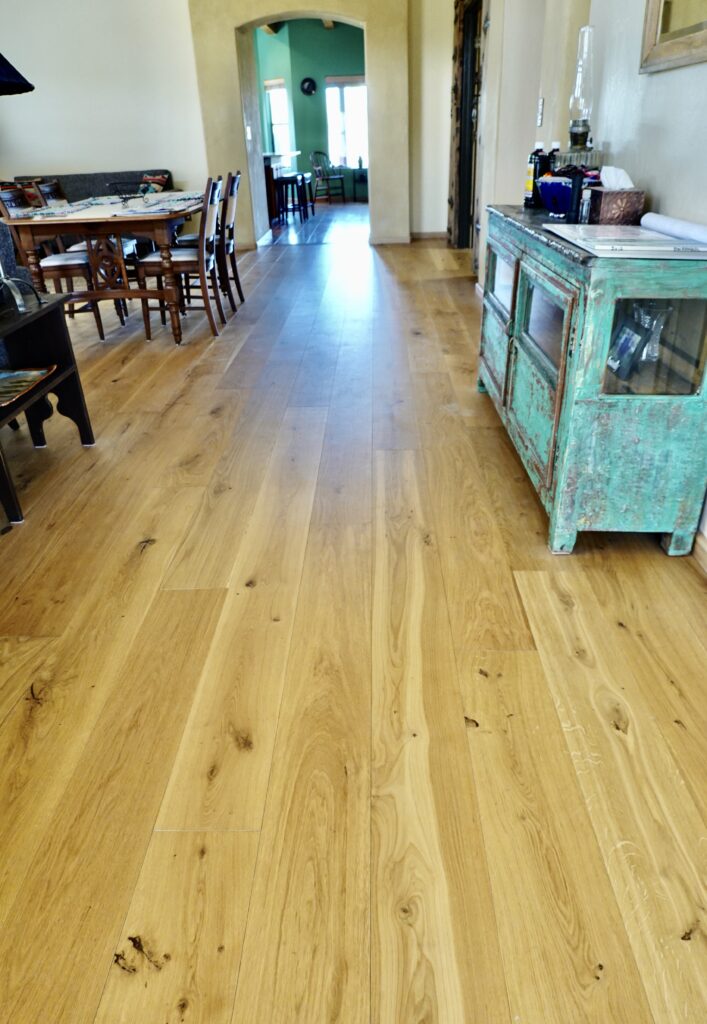
What are Your Finish Choices for Wood Flooring?
April 10, 2023
When you start shopping for hardwood and engineered hardwood flooring the finish on top of the wood is an important consideration. For factory finishes, you find two popular categories. Deciding between the two not only is an aesthetic decision but is also a maintenance decision.
Urethane, Polyurethane, Lacquer
The first and most common wood flooring finish involves urethane, polyurethane, or lacquer. This type of finish is applied on top of the wood and creates a barrier to the wood surface. Sometimes aluminum oxide is added to create a harder surface that is more abrasion resistant. Urethane, polyurethane, and lacquer finishes are often UV cured. All three come in oil-based and water-based options.

Hardwax Oil
The second type of finish, hard wax oil, has been gaining in popularity over the last two decades. The matte finish shows off the wood and does not highlight scratches. This finish uses an oil that penetrates the wood surface fortifying and sealing the wood. With hardwax oil you are walking on a wood surface, with urethane and lacquer you are walking on a man-made barrier. The hardwax oil finishes can also be UV cured to catalyze the oil for shorter drying times which means the manufacturer can get the flooring out to you faster. Normally oil waxes have a longer cure time.
History
Oils and waxes have been used to protect wood throughout history. Old European buildings with their original floors show that oils can protect a wood floor for hundreds of years. Oils and waxes were replaced by synthetic protectors such as urethane, polyurethane, and lacquer, during the 1900s. These newer finishes became popular because they were water-resistant, easy to clean and the coating protected against scratches.
But the old methods are making a comeback because oil and wax bring out the beauty of wood – revealing the open grain, having a matte finish, and feeling natural underfoot. The matte finish of hardwax oil does not show scuffs and scratches as easily as the surface of glossy urethanes. In the last 5 years, urethanes are available in more sheen options including matte sheens which mimic hardwax oil finish.

Care and Maintenance
Urethane, Polyurethane, Lacquer
The big difference between these finishes is the care and maintenance. There is less maintenance for the urethane floors but when they need to be refinished the original surface must be sanded off. This means moving all of your furniture, lots of sanding, and recoating, which takes time and displaces you from your home short term. You are also sanding away a layer of your floor and a wood floor has a finite number of times it can be refinished. Care for urethane is easy, sweep, vacuum, or use a dry mop to remove dust and debris, then damp mop with an approved cleaner for your floor. Manufacturers usually recommend cleaners and care information for their flooring. Urethane, polyurethane, and lacquer finishes usually have a 20+ year warranty. So refinishing your floor is not going to happen often. The difficulty with this finish is that it is not easily repairable. If you get a deep gouge or scratches you may have to replace a plank or refinish the entire floor. There is not the ease of spot repairs as with hardwax oil finishes.

Water-based UV Lacquer.
Hardwax Oil
Hardwax oil floors require maintenance more often but do not require any sanding to recoat. This means you will not be displaced from your home while recoating. And because you are not sanding a layer of your floor away the thickness of the original wood stays intact. For everyday care, you can sweep, vacuum, and dry mop. Cleaning with specific cleansers is important, the oils can be stripped from the floor if anything with alcohol or other harsh ingredients is used. Always read which cleanser the manufacturer recommends when damp mopping. Repairs are easily done with hardwax oil, scratches can be spot repaired with an application of maintenance oil. Recoating should happen every 4-7 years depending on wear.
Choosing which wood flooring finish fits your lifestyle best is the hardest part. With polyurethanes and lacquer you get durability and ease of care. With hardwax oil you get durability, a natural matte finish, and the ability to easily repair scratches or scuffs.
